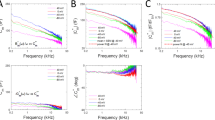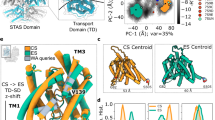Abstract
Forces developed by cochlear outer hair cells (OHCs) are responsible for the sharp tuning that underlies sensitivity and frequency selectivity in the ear. OHCs exhibit a voltage-dependent motility involving a 'motor' protein embedded in the basolateral membrane. The motor has so far resisted molecular identification. Here we provide evidence that it may be related to a fructose transporter. We show that OHCs are able to transport this sugar selectively and that the sugar alters electrical properties of the OHC motor. These data can be combined into an integrated model of a sugar carrier, that makes the novel prediction, demonstrated here, that such 'neutral' transporters can be voltage dependent.
This is a preview of subscription content, access via your institution
Access options
Subscribe to this journal
Receive 12 print issues and online access
$209.00 per year
only $17.42 per issue
Buy this article
- Purchase on Springer Link
- Instant access to full article PDF
Prices may be subject to local taxes which are calculated during checkout







Similar content being viewed by others
References
Davis, H. An active process in cochlear mechanics. Hearing Res. 9, 79–90 (1983).
Russell, I. J., Cody, A. R. & Richardson, G. P. in Cellular Mechanisms in Hearing (eds. Flock, A. & Wersäll, J.) 199–216 (Elsevier, Amsterdam, 1986).
Brownell, W. E., Bader, C. R., Bertrand, D. & De Ribaupierre, Y. Evoked mechanical responses of isolated cochlear hair cells. Science 227, 194–196 ( 1985).
Ashmore, J. F. A fast motile reponse in guinea-pig outer hair cells: the cellular basis of the cochlear amplifier. J. Physiol. (Lond.) 388, 323–347 (1987).
Kachar, B., Brownell, W. E., Altschuler, R. & Fex, J. Electrokinetic shape changes of cochlear outer hair cells. Nature 322, 365–368 ( 1986).
Holley, M. C. & Ashmore, J. F. On the mechanism of a high frequency force generator in outer hair cells isolated from the guinea pig cochlea. Proc. R. Soc. Lond. B Biol. Sci. 232, 413 –429 (1988).
Iwasa, K. H., Li, M. & Jia, M. Can membrane proteins drive a cell? Biophys. J. 68, 214s (1995).
Kalinec, E., Holley, M. C., Iwasa, K. H., Lim, D. J. & Kachar, B. A membrane-based force generation mechanism in auditory sensory cells. Proc. Natl. Acad. Sci. USA 89, 8671–8675 ( 1992).
Ashmore, J. F. Forward and reverse transduction in the mammalian cochlea. Neurosci. Res. (Suppl.) 12, 39–50 (1990).
Santos-Sacchi, J. Reversible inhibition of voltage-dependent outer hair cell motility and capacitance. J. Neurosci. 11, 3096– 3110 (1991).
Gale, J. E. & Ashmore, J. F. The outer hair cell motor in membrane patches. Pflugers Arch. 434, 267 –271 (1997).
Knipper, M. et al. Immunological identification of candidate proteins involved in regulating active shape changes of outer hair cells. Hearing Res. 86, 100–110 ( 1995).
Kalinec, F., Kalinec, G., Negrini, C. & Kachar, B. Immunolocalization of anion exchanger 2α in auditory sensory hair cells. Hearing Res. 110, 141–146 ( 1997).
Gale, J. E. & Ashmore, J. F. An intrinsic frequency limit to the cochlear amplifier. Nature 389, 63 –66 (1997).
Huang, G. & Santos-Sacchi, J. Motility voltage sensor of the outer hair cell resides within the lateral plasma membrane. Proc. Natl. Acad. Sci. USA 91, 12268– 12272 (1994).
Dallos, P. & Evans, B. N. High-frequency motility of outer hair cells and the cochlear amplifier. Science 267, 2006–2009 (1995).
Nakazawa, K., Spicer, S. S. & Schulte, B. A. Postnatal expression of the facilitated glucose transporter, GLUT 5, in gerbil outer hair cells. Hearing Res. 82 , 93–99 (1995).
Gould, G. W., Thomas, H. M., Jess, T. J. & Bell, G. I. Expression of human glucose transporters in Xenopus oocytes: kinetic characterization and substrate specificities of the erythrocyte, liver, and brain isoforms. Biochemistry 30, 5139– 5145 (1991).
Colville, C.A., Seatter, M. J. & Gould, G. W. Analysis of the structural requirements of sugar binding to the liver, brain and insulin-responsive glucose transporters expressed in oocytes. Biochem. J. 294, 753– 760 (1993).
Gould, G. W. & Holman, D. The glucose transporter family: structure, function and tissue-specific expression. Biochem. J. 295, 329–341 (1993).
Miyamoto, K. et al. Characterization of the rabbit intestinal fructose transporter (GLUT5). Biochem. J. 303, 877– 883 (1994).
Iwasa, K. H. Effect of stress on the membrane capacitance of the auditory outer hair cell. Biophys. J. 65, 492–498 (1993).
Gale, J. E. & Ashmore, J. F. Charge displacement induced by rapid stretch in the basolateral membrane of guinea-pig outer hair cell. Proc. R. Soc. Lond. B Biol. Sci. 255, 243– 249 (1994).
Huang, G. & Santos-Sacchi, J. Mapping the distribution of the outer hair cell motility voltage sensor by electrical amputation. Biophys. J. 65, 2228–2236 (1993).
Forge, A. Structural features of the lateral walls in mammalian cochlear outer hair cells. Cell Tissue Res. 265, 473– 483 (1991).
Souter, M., Nevill, G. & Forge, A. Postnatal development of membrane specialisations of gerbil outer cells. Hearing Res. 91, 43– 62 (1995).
Gould, G. W. & Bell, G. I. Facilitative glucose transporters: an expanding family. Trends Biochem. Sci. 15, 18–23 (1990).
Pessino, A. et al. Evidence that functional erythrocyte-type glucose transporters are oligomers. J. Biol. Chem. 266, 20213 –20217 (1991).
Zottola, R. J. et al. Glucose transporter function is controlled by transporter oligomeric structure. A single, intramolecular disulfide promotes GLUT1 tetramerization. Biochemistry 34, 9734– 9747 (1995).
Eskandari, S. et al. Structural analysis of cloned plasma membrane proteins by freeze-fracture electron microscopy. Proc. Natl. Acad. Sci. USA 95, 11235–11240 ( 1998).
Iwasa, K. H. A membrane motor model for the fast motility of the outer hair cell. J. Acoust. Soc. Am. 96, 2216–2224 (1994).
Holley, M. C. A simple in vitro method for raising monoclonal antibodies to cochlear proteins. Tissue Cell 24, 613–624 (1992).
Carruthers, A. Sugar transport in animal cells: the passive hexose transfer system. Prog. Biophys. Mol. Biol. 43, 33–69 (1984).
Weiss, T. F. Cellular Biophysics: Transport: Vol. 1 360– 396 (MIT Press, Cambridge, 1996).
Hamill, O. P., Marty, A., Neher, E., Sakmann, B. & Sigworth, F. J. Improved patch clamp technique for high resolution current recording from cells and cell free membrane patches. Pflugers Arch. 391, 85–100 ( 1981).
Fuchs, P. A. & Evans, M. G. Potassium currents in hair cells isolated from the cochlea of the chick. J. Physiol. (Lond.) 429, 529–551 (1990).
Armstrong, C. M. & Bezanilla, F. Charge movement associated with the opening and closing of the activation gates of the Na channels. J. Gen. Physiol. 63, 533– 552 (1974).
Neher, E. & Marty, A. Discrete changes of cell membrane capacitance observed under conditions of enhanced secretion in bovine adrenal chromaffin cells. Proc. Natl. Acad. Sci. USA 79, 6712–6716 (1982).
Joshi, C. & Fernandez, J. M. Capacitance measurements: An analysis of the phase detector technique used to study exocytosis and endocytosis. Biophys. J. 53, 885–892 (1988).
Acknowledgements
This work was supported by the Wellcome Trust. We thank Matthew Holley, Peter Mobbs and Luca Turin for comments on an earlier version of the manuscript. S.O.C. is supported by a George John Livanos Charitable Trust Fellowship.
Author information
Authors and Affiliations
Corresponding author
Rights and permissions
About this article
Cite this article
Géléoc, G., Casalotti, S., Forge, A. et al. A sugar transporter as a candidate for the outer hair cell motor. Nat Neurosci 2, 713–719 (1999). https://doi.org/10.1038/11174
Received:
Accepted:
Issue Date:
DOI: https://doi.org/10.1038/11174
This article is cited by
-
Developmental Expression of the Outer Hair Cell Motor Prestin in the Mouse
Journal of Membrane Biology (2007)
-
Imaging by Atomic Force Microscopy of the Plasma Membrane of Prestin-Transfected Chinese Hamster Ovary Cells
Journal of the Association for Research in Otolaryngology (2006)
-
Tuning in to the Amazing Outer Hair Cell: Membrane Wizardry with a Twist and Shout
Journal of Membrane Biology (2006)
-
A genetic approach to understanding auditory function
Nature Genetics (2001)
-
Ion-age molecular motors
Nature Neuroscience (2001)



